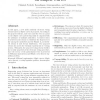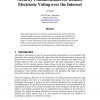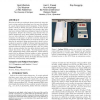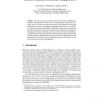124
click to vote
IJNSEC
2011
14 years 7 months ago
2011
In this paper, a new multi authority electronic voting scheme based on elliptic curves is proposed. According to the proposed scheme, each voter casts the vote as a point on the e...
85
Voted
CACM
2002
15 years 18 days ago
2002
This paper discusses the security considerations for remote electronic voting in public elections. In particular, we examine the feasibility of running national federal elections ...
97
Voted
SIGCSE
2008
ACM
15 years 21 days ago
2008
ACM
This paper describes CyberCivics, a novel approach to computer science outreach that integrates hands-on computing experiences with the study of contemporary social and political ...
117
Voted
EG
2007
15 years 22 days ago
2007
: Electronic voting may be a feasible option for several election environments, from closed-group elections to nation-wide elections. Especially with online voting, people will be ...
115
Voted
INTR
2006
15 years 23 days ago
2006
Abstract. Typically each voter contributes with one vote for an election. But there are some elections where voters can have different weights associated with their vote. In this p...
84
Voted
CORR
2008
Springer
15 years 26 days ago
2008
Springer
: Observing electronic voting from an international point of view gives some perspective about its genesis and evolution. An analysis of the voting process through its cultural, on...
114
Voted
CCS
2010
ACM
15 years 1 months ago
2010
ACM
Elections in India are conducted almost exclusively using electronic voting machines developed over the past two decades by a pair of government-owned companies. These devices, kn...
114
click to vote
ESORICS
2010
Springer
15 years 1 months ago
2010
Springer
We present a formal, symbolic definition of election verifiability for electronic voting protocols in the context of the applied pi calculus. Our definition is given in terms of bo...
111
Voted
FOSAD
2008
Springer
15 years 2 months ago
2008
Springer
This paper discusses how electronic voting was implemented in practice in the Netherlands, which choices were made and how electronic voting was finally abolished. This history is ...
107
Voted
USS
2008
15 years 3 months ago
2008
Commercial electronic voting systems have experienced many high-profile software, hardware, and usability failures in real elections. While it is tempting to abandon electronic vo...




